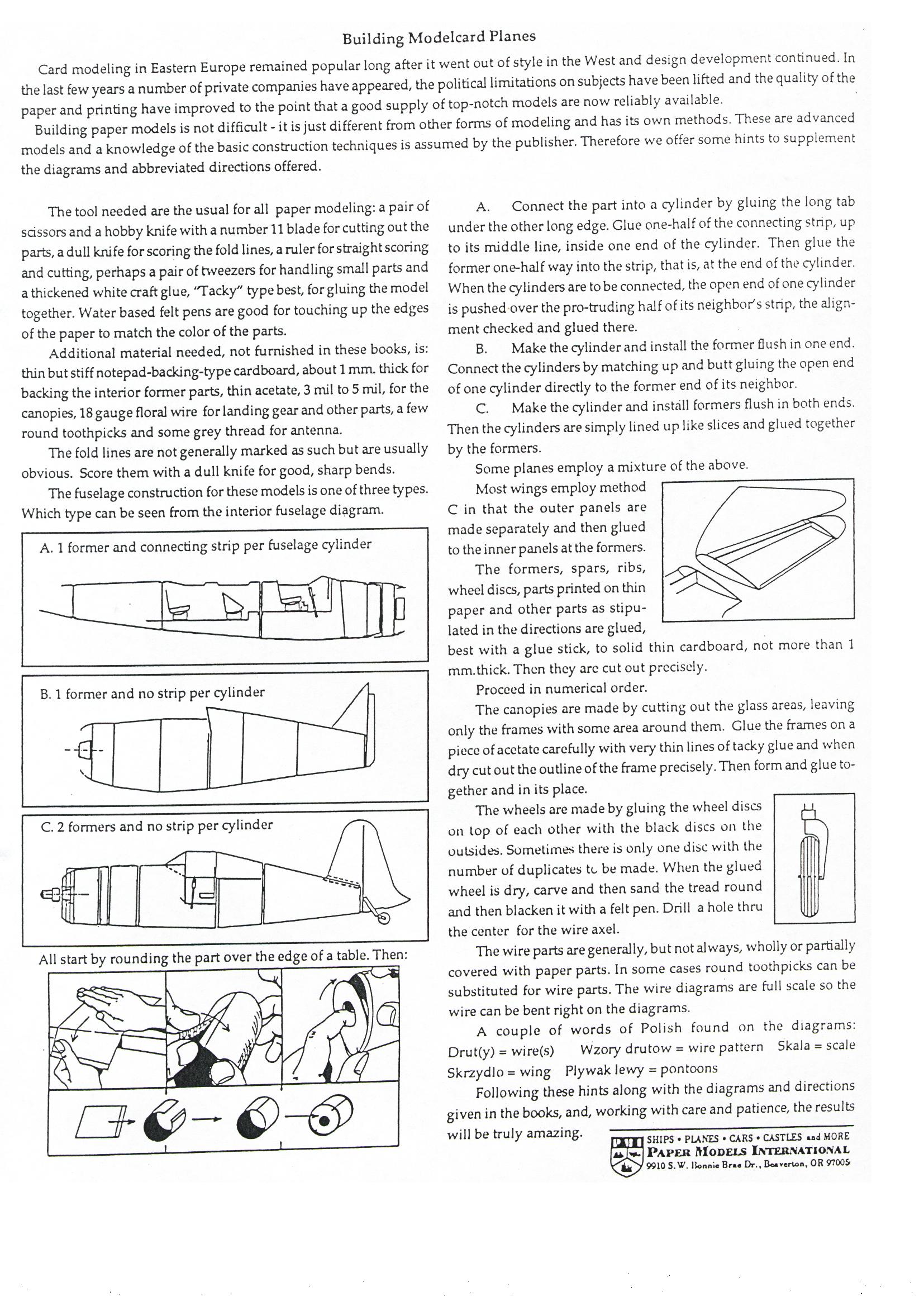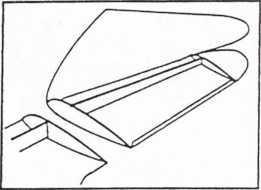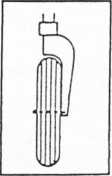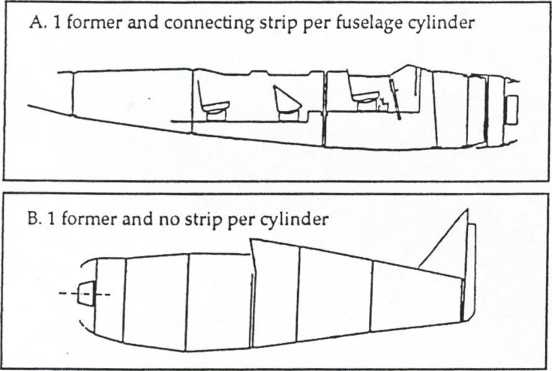F3F 1pmi instr A4

Building Modelcard Planes
Card modeling in Eastern Europę remained popular long after it went out of style in the West and design development continued. In the last few years a number of private companies have appeared, the political limitations on subjects have been lifted and the quality of the paper and printing have improved to the point that a good supply of top-notch models are now reliably available.
Building paper models is not difficult - it is just different from other forms of modeling and has its own methods. These are advanced models and a knowledge of the basie construction techniques is assumed by the publisher. Therefore we offer some hints to supplement the diagrams and abbreviated directions offered.

All start by rounding the part over the edge of a table. Then:
|
Yry A/ ilEry- |
/rf JL J -i / / |
)a | |
|
_1__ | |||



SHIPS • PLANES • CARS • CASTLES and MORĘ
Paper Modejls Internat i on a l
9910 S.W. Ilonni. Brna Dr., Baa.erton, OR 97005
The tool needed are the usual for all paper modeling: a pair of sdssors and a hobby knife with a number 11 blade for cutting out the parts, a duli knife for scoring the fold lines, a ruler for straight scoring and cutting, perhaps a pair of tweezers for handling smali parts and athickened white CTaftglue, 'Tacky" typebest, forgluing the model together. Water based felt pens are good for touching up the edges of the paper to match the color of the parts.
Additional materiał needed, not furnished in these books, is: thin but stiff notepad-backing-type cardboard, about 1 mm. thick for backing the interior former parts, thin acetate, 3 mil to 5 mil, for the canopies, 18 gauge floral wire for landing gear and other parts, a few round toothpicks and some grey thread for antenna.
The fold lines are not generally marked as such but are usually obvious. Score them with a duli knife for good, sharp bends.
The fuselage construction for these models is one of three types. Which type can be scen from the interior fuselage diagram.

A. Connect the part into a cylinder by gluing the long tab under the other long edge. Glue one-half of the connecting strip, up to its middle linę, inside one end of the cylinder. Then glue the former one-half way into the strip, that is, at the end of the cylinder. When the cylinders are to be connected, the open end of one cylinder is pushed over the pro-truding half of its neighboris strip, the align-ment checked and glued there.
B. Make the cylinder and install the former flush in one end. Connect the cylinders by matching up and butt gluing the open end of one cylinder directly to the former end of its neighbor.
C. Make the cylinder and install formers flush in both ends. Then the cylinders are simply lined up like slices and glued together by the formers.
Some planes employ a mixture of the above.
Most wings employ method C in that the outer panels are madę separately and then glued to the inner panels at the formers.
The formers, spars, ribs, wheel dises, parts printed on thin paper and other parts as stipu-lated in the directions are glued, best with a glue stick, to solid thin cardboard, not morę than 1 mm.thick. Then they are cut out prccisely.
Procced in numerical order.
The canopies are madę by cutting out the glass areas, leaving only the frames with some area around them. Glue the frames on a piece of acetate carcfully with very thin lines of tacky glue and when dry cut out the outline of the frame precisely. Then form and glue together and in its place.
The wheels are madę by gluing the wheel dises on top of each other with the black dises on the oulsides. Sometimes there is only one disc with the number of duplicates to be madę. When the glued wheel is dry, carve and then sand the tread round and then blacken it with a felt pen. Drill a hole thru the center for the wire axel.
The wire parts are generally, but not al ways, wholly or partially covered with paper parts. In some cases round toothpicks can be substituted for wire parts. The wire diagrams are fuli scalę so the wire can be bent right on the diagrams.
A couple of words of Polish found on the diagrams: Drut(y) = wire(s) Wzory drutów = wire pattern Skala = scalę Skrzydło = wing Pływak lewy = pontoons
Following these hints along with the diagrams and directions given in the books, and, working with care and patience, the results will be truły amazing.
Wyszukiwarka
Podobne podstrony:
Dibujo2 44 1 Building Modelcard Planes Card modeling in Eastern Europę remained popular long after i
AUC generates triplets used in the authentication of SIM card and used in the ciphering of speech, d
Intelligent building, automated... 219 Table 1 Chart showing the increase in the number of car parks
Introduction INTRODUCTION The Basilica of St. Peter is one of the most important eccle-siastical bui
New Forms Taschen 048 Transport, Communications, Tali Buildings and the Urban Nomad Continuing urban
ninjas Play this card at any time except during an attack to put any one uncontrolled grou
Zał. nr 4 do ZW 64/2012 FACULTY OF ELECTRONICS SUBJECT CARD Name in Polish Miernictwo 2 Name in
Zał. nr 4 do ZW 64/2012 FACULTY OF ELECTRONICS SUBJECT CARD Name in Polish Grafika
Zał. nr 3 do ZW FACULTY OF ELECTRONICS SUBJECT CARD Name in Polish: Podstawy
Zał. nr 4 do ZW 64/2012 FACULTY ELECTRONICS SUBJECT CARD Name in Polish Podstawy automatyki i
Zał. nr 4 do ZW 64/2012 FACULTY ELECTRONICS SUBJECT CARD Name in Polish Podstawy przetwarzania
Zał. nr 4 do ZW 64/2012 FACULTY OF ELECTRONICS SUBJECT CARD Name in Polish Miernictwo 1 Name in En
Architecture Art Nouveau architecture in Riga makes up roughly one third of all buildings in the cen
więcej podobnych podstron